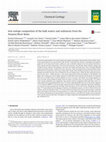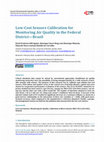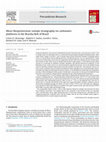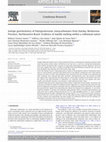Papers by Luis H E N R I Q U E Mancini

Brazilian Journal of Geology, 2016
ABSTRACT: The present work investigates the relationship between whole-rock geochemistry and stab... more ABSTRACT: The present work investigates the relationship between whole-rock geochemistry and stable isotope composition from carbonatites belonging to the Tapira, Araxá, Salitre, Serra Negra, Catalão I, and Catalão II alkaline-carbonatite complexes of the Alto Paranaiba Igneous Province (APIP), central Brazil and from the Jacupiranga Complex, of the Ponta Grossa Province, southeast Brazil. The APIP complexes are ultrapotassic, comprising bebedourites, phoscorites, nelsonites, and carbonatites, whereas Jacupiranga is a sodic complex composed of ijolite-series rocks, syenites, carbonatites, and alkaline gabbros. The geochemistry data allied to mineralogical constraints allowed us to classify the carbonatites into five groups, and to devise a chemical index (BaO/(BaO+SrO)) to gauge the magmatic evolution of the studied carbonatites.The APIP carbonatites evolve from apatite-rich calciocarbonatites toward Ba-, Sr-, and rare earth element (REE)-rich magnesiocarbonatites. This evolution is...

Brazilian Journal of Geology, 2016
ABSTRACT: The present work investigates the relationship between whole-rock geochemistry and stab... more ABSTRACT: The present work investigates the relationship between whole-rock geochemistry and stable isotope composition from carbonatites belonging to the Tapira, Araxá, Salitre, Serra Negra, Catalão I, and Catalão II alkaline-carbonatite complexes of the Alto Paranaiba Igneous Province (APIP), central Brazil and from the Jacupiranga Complex, of the Ponta Grossa Province, southeast Brazil. The APIP complexes are ultrapotassic, comprising bebedourites, phoscorites, nelsonites, and carbonatites, whereas Jacupiranga is a sodic complex composed of ijolite-series rocks, syenites, carbonatites, and alkaline gabbros. The geochemistry data allied to mineralogical constraints allowed us to classify the carbonatites into five groups, and to devise a chemical index (BaO/(BaO+SrO)) to gauge the magmatic evolution of the studied carbonatites.The APIP carbonatites evolve from apatite-rich calciocarbonatites toward Ba-, Sr-, and rare earth element (REE)-rich magnesiocarbonatites. This evolution is...

Chemical Geology, 2014
The present study provides iron concentrations and isotopic compositions determined by multi-coll... more The present study provides iron concentrations and isotopic compositions determined by multi-collector inductively coupled plasma mass spectrometry (MC-ICP-MS), along with key chemical, mineralogical and physical properties of 35 representative bulk (unfiltered) waters and bulk sediments from the Amazon River Basin. These samples from the Amazon River, five of its main tributaries (the Solimões, Negro, Madeira, Tapajós and Trombetas rivers) and four sub-tributaries (the Purus, Jaú, Ucayali and Napo rivers) were essentially collected during seven field missions conducted for over two years. These encompassed the centennial flood of May 2009 and the exceptional low water stage of September-October 2010, thereby providing the most extreme hydrological situations that have been recorded over the last hundred years. While the data confirmed massive losses of iron (up to~19 000 tons/day, ca. 50% of the Amazon River bulk water budget) in the Solimões and Negro rivers mixing zone, the Fe isotope signatures of these bulk waters behaved conservatively. This property allows the use of bulk water Fe isotope signature to track iron sources and explain such isotopic signature in terms of simple mixing. Unfiltered samples from the organic-rich black water rivers present light δ 57 Fe relative to the average continental crust composition. This contrasts with the composition of the bulk white waters carrying a high mineral suspended load that have δ 57 Fe values undistinguishable from the crustal isotopic signature (~0.1‰ relative to . This observation indicates that the Fe isotopic composition represents a reliable direct tracer of the iron speciation and, therefore, of the host phases of iron in its sources. Specifically, the white water δ 57 Fe most likely trace the signatures of igneous and sedimentary sources, as well as of their lateritic soil minerals, while the bulk black water δ 57 Fe track a preferential release of Fe that has gone through a reduction step in the organic-rich horizons of tropical podzols as a result of the biological activity. This study shows that the total iron transferred by the Amazon River represents between 5 and 30% of the world's ocean Fe input by rivers, and this Amazon bulk water iron displays an isotopic composition indistinguishable from that of the average continental crust.

Strongly-deformed marbles may be easily confused with linear and elongated carbonatite intrusions... more Strongly-deformed marbles may be easily confused with linear and elongated carbonatite intrusions. Both rocks may present similar texture and foliation to the host rock, or even cross cutting field relationships, which could be interpreted either as igneous or high-grade metamorphosed marble. Diagnostic criteria are even more complex when there is evidence of melting of the metasedimentary carbonate rock, such as has been described in the Himalayas and in the Eastern Ghats, India. In the Alto Moxotó Terrane, a high-grade gneissic domain of the Borborema Province, Northeastern Brazil, there are metacarbonates associated with banded gneisses and different metaplutonic rocks. Field evidence indicates the absence of other metasedimentary rocks associated with these marbles, thus suggesting that these carbonates were separated from other siliciclastic metasedimentary rocks. The presence of marble also suggests that it may represent the initial stage of a crustal carbon recycling into the...

Journal of Environmental Protection, 2015
Critical situations that cannot be solved by conventional approaches (traditional air quality mon... more Critical situations that cannot be solved by conventional approaches (traditional air quality monitoring networks), have the possibility of being managed quickly by a wide network of portable systems with sensors. The purpose of this research was to calibrate and validate low-cost sensors. Pilot indoor and outdoor areas, in the central area of Brasilia (Brazil's capital city) were chosen for corporative performance evaluation of the sensors. The CO at 99.999% volumetric injection method has been used in a gas test box, among two MiCS-5521 (CO/VOC) sensors, one being new and the other one with a short useful life. The number of injections adopted to each volume (from 1 ml to 6 ml) was 10, rising each sensor's confidence interval mean. A increase of the injected volume (ml) of CO resulted in significant decrease in a resistance (Ohms), as shown by a good inverse relationship on the interaction of these two variables (r = 0.88), with good measurement accuracy, when compared to the manufacturer's reference datasheet. Finally, a geospatial management system was built for the pollution data measured by the low-cost sensors.

Geochimica et Cosmochimica Acta, 2015
ABSTRACT The present study investigated the weathering and transport mechanisms of Fe in the Amaz... more ABSTRACT The present study investigated the weathering and transport mechanisms of Fe in the Amazon River. A particular emphasis was placed on Fe partitioning, speciation, and isotopic fractionation in the contrasting waters of the Solimões and Negro rivers and their mixing zone at the beginning of the Amazon River. Samples collected in the end-member rivers and thirteen sites distributed throughout the mixing zone were processed through frontal vacuum filtration and tangential-flow ultrafiltration to separate the different suspended solid fractions, i.e., particulate (P > 0.45 μm and P > 0.22 μm), colloidal (0.22 μm > C > 5 kDa) and truly dissolved elements (TD < 5 kDa). The Fe isotopic composition and electron paramagnetic resonance (EPR) species were measured on these different pore-sized fractions. The acidic and organo-Fe-rich waters of the Negro River displayed dissolved and colloidal fractions enriched in heavy isotopes (∼1.2‰, in δ57Fe values relative to IRMM-14), while the particulate fractions yielded light isotopic compositions of −0.344‰ for P > 0.22 μm and −0.104‰ for P > 0.45 μm fractions). The mineral particulate-rich waters of the Solimões River had dissolved and colloidal fractions with light isotopic composition (−0.532‰ and −0.176‰, respectively), whereas the particulate fractions yielded δ57Fe values close to those of the continental crust (i.e., −0.029‰ for P > 0.22 μm and 0.028‰ for P > 0.45 μm). Ten kilometers downstream from the Negro and Solimões junction, the concentrations of colloidal and dissolved Fe species deviate markedly from conservative mixing. A maximum Fe loss of 43 μg/L (i.e., 50% of the dissolved and colloidal Fe) is observed 110 km downstream from the rivers junction. The contrasting Negro and Solimões Rivers isotopic compositions along the pore-sized water fractions is attributable to the biogeochemical processes involving different types of upland soils and parental materials. For instance, the isotopic composition of colloidal and dissolved Fe from the Negro River are consistent with Fe oxidation and complexation mechanisms at the interface between waterlogged podzols and river networks, as supported by strong organo-Fe complexes signals observed by EPR. Conversely, the particulate and colloidal fractions from the Solimões River have δ57Fe consistent with strong mechanical erosion in the Andean Cordillera and upland soils, as evidenced by high concentrations of Fe3+-oxides sensu lato measured by EPR. The massive dissolved and colloidal Fe removal is associated with the evolution of the physical and chemical composition of the waters (i.e., ionic strength) during mixing, which influences organo-Fe3+ and Fe3+-oxyhydroxides stability. Several models are discussed to explain Fe non-conservative behavior, including dissociation of organo-Fe complexes and the subsequent formation of solid Fe3+-oxyhydroxides and semiquinone free radicals, as evidenced by EPR spectra demonstrating that organo-Fe signals decrease as Fe3+-oxyhydroxides and free radicals signals increase. As in estuarine regions, the mechanisms involving Fe transfer and loss in the mixing zone has a negligible effect on the bulk water Fe isotopic composition. This result suggests that a tropical basin similar to the Amazon River Basin delivers to the ocean waters with an Fe isotopic composition similar to that of the Earth’s continental crust.

Precambrian Research, 2014
Carbonate platforms were present worldwide during the Proterozoic Eon, and variations in their C ... more Carbonate platforms were present worldwide during the Proterozoic Eon, and variations in their C and Sr isotope ratios are commonly used as a correlation tool particularly through the Neoproterozoic, when rapid secular change in marine C and Sr isotope values permit distinction between Cryogenian glacial events. In central Brazil, the late Mesoproterozoic and Neoproterozoic eras are represented by a thick succession of sedimentary rocks that were deposited, and later deformed, along the eastern margin of the São Francisco Craton. These strata are divided into the three major groups: (1) the Paranoá Group, which consists of a succession of sandstone, siltstone, rhythmite, and selected intervals of carbonate, (2) the Macaúbas Group, which consists of a glacial diamictite (Jequitaí Formation), and (3) the Bambuí Group with an important carbonate-bearing succession that includes characteristic "cap carbonate" facies in its lower strata. Carbonate facies of Paranoá and Bambuí Groups typically occur in unconformable contact, and when the diamictite of Jequitaí Formation is absent, it can be difficult to determine the stratigraphic position of these lithological similar groups. Furthermore, uncertainties in the age of the Bambuí Group has lead to several distinct interpretations regarding the age of the Jequitaí glacial diamictites.

Gondwana Research, 2013
Strongly-deformed marbles may be easily confused with linear and elongated carbonatite intrusions... more Strongly-deformed marbles may be easily confused with linear and elongated carbonatite intrusions. Both rocks may present similar texture and foliation to the host rock, or even cross cutting field relationships, which could be interpreted either as igneous or high-grade metamorphosed marble. Diagnostic criteria are even more complex when there is evidence of melting of the metasedimentary carbonate rock, such as has been described in the Himalayas and in the Eastern Ghats, India. In the Alto Moxotó Terrane, a high-grade gneissic domain of the Borborema Province, Northeastern Brazil, there are metacarbonates associated with banded gneisses and different metaplutonic rocks. Field evidence indicates the absence of other metasedimentary rocks associated with these marbles, thus suggesting that these carbonates were separated from other siliciclastic metasedimentary rocks. The presence of marble also suggests that it may represent the initial stage of a crustal carbon recycling into the mantle. These marbles present many field similarities to carbonatites (e.g., fluid-flow structure) and, together with metagranites and metamafic intrusions, may represent a major collisional tectonic suture. A detailed study of the carbon, oxygen and strontium isotopic composition of these marbles is presented. This study aims to identify the origin of the different isotopic components. It is argued that these rocks were subjected to temperature and pressure conditions that were sufficiently high to have melted them. The isotopic data presented here support this interpretation and indicate the mixing of two components: (i) one characterized by radiogenic Sr isotopes and mantle-like carbon isotopes, which is associated with the gneissic and mafic rocks, and (ii) another characterized by low 87 Sr/ 86 Sr ratios and highly positive δ 13 C values. Available geochemical data for the upper Paleoproterozoic indicate that the 87 Sr/ 86 Sr ratio of ocean water, varying between 0.7050 (2.25 ± 0.25 Ga) and 0.7047 (1.91 Ga), falls within the lower range of the samples from Itatuba and thus reinforces the interpretation that these marbles are sedimentary-derived and were partially contaminated by interaction with the host gneissic and mafic rocks.
ABSTRACT Tese (Doutorado)--Instituto de Geociências e Ciências Exatas da Universidade Estadual Pa... more ABSTRACT Tese (Doutorado)--Instituto de Geociências e Ciências Exatas da Universidade Estadual Paulista.

The present study provides iron concentrations and isotopic compositions determined by multi-coll... more The present study provides iron concentrations and isotopic compositions determined by multi-collector inductively coupled plasma mass spectrometry (MC-ICP-MS), along with key chemical, mineralogical and physical properties of 35 representative bulk (unfiltered) waters and bulk sediments from the Amazon River Basin. These samples from the Amazon River, five of its main tributaries (the Solimões, Negro, Madeira, Tapajós and Trombetas rivers) and four sub-tributaries (the Purus, Jaú, Ucayali and Napo rivers) were essentially collected during seven field missions conducted for over two years. These encompassed the centennial flood of May 2009 and the exceptional low water stage of September-October 2010, thereby providing the most extreme hydrological situations that have been recorded over the last hundred years. While the data confirmed massive losses of iron (up to~19 000 tons/day, ca. 50% of the Amazon River bulk water budget) in the Solimões and Negro rivers mixing zone, the Fe isotope signatures of these bulk waters behaved conservatively. This property allows the use of bulk water Fe isotope signature to track iron sources and explain such isotopic signature in terms of simple mixing. Unfiltered samples from the organic-rich black water rivers present light δ 57 Fe relative to the average continental crust composition. This contrasts with the composition of the bulk white waters carrying a high mineral suspended load that have δ 57 Fe values undistinguishable from the crustal isotopic signature (~0.1‰ relative to . This observation indicates that the Fe isotopic composition represents a reliable direct tracer of the iron speciation and, therefore, of the host phases of iron in its sources. Specifically, the white water δ 57 Fe most likely trace the signatures of igneous and sedimentary sources, as well as of their lateritic soil minerals, while the bulk black water δ 57 Fe track a preferential release of Fe that has gone through a reduction step in the organic-rich horizons of tropical podzols as a result of the biological activity. This study shows that the total iron transferred by the Amazon River represents between 5 and 30% of the world's ocean Fe input by rivers, and this Amazon bulk water iron displays an isotopic composition indistinguishable from that of the average continental crust.

Uploads
Papers by Luis H E N R I Q U E Mancini